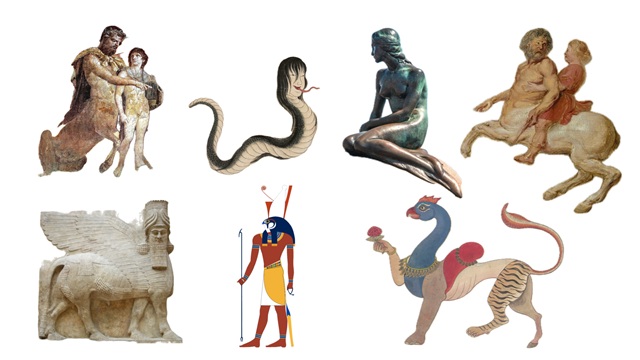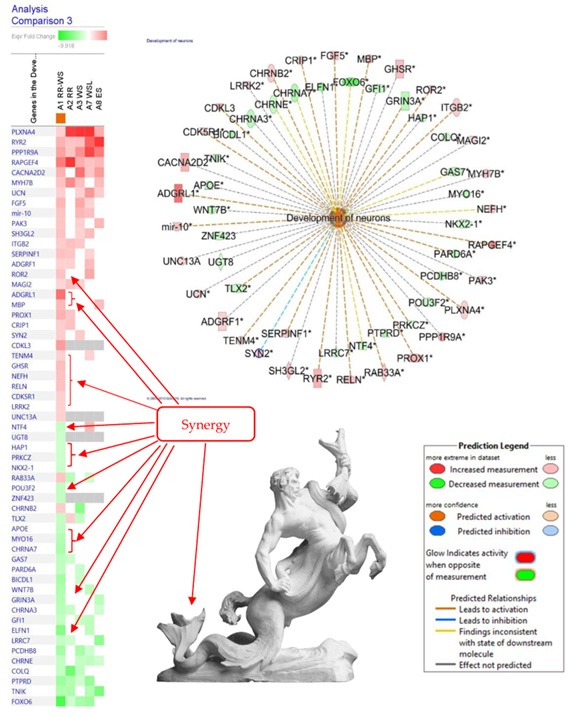Synergy and antagonism
“Two or more agents working together to produce a result not obtainable by any of the agents independently”
In 1957, Goldin and Mantel suggested that “Synergy and antagonism imply that the different constituents affect each other’s actions” assuming that “if
it is synergistic, the drugs will be more effective in combination than separately” (Goldin and Mantel, 1957). Thus, one of two commonly used definitions of synergy in pharmacology and pharmacognosy is related to efficacy, effectiveness, and potency of the combinations of two agents with the same pharmacological activity: “A combination of agents that ismore effective than is expected from the effectiveness of its constituents is said to show synergy” (Berenbaum, 1977).
Another definition of synergy is formulated as “two or more agents working together to produce a result not obtainable by any of the agents independently”
and can be interpreted as generation of new pharmacological activity, which is specific only for the combination of two or more agents (Panossian et al., 2018; Panossian at al. 2015; Panossian et al., 2013; Skirven et.al., 2011).
In this context, it would be reasonable to distinguish among definitions of synergy and implement more relevant definitions for assessing efficacy or effectiveness of the combination (hybrid substance C) of efficacy substances A and B, such as:
•synergy, if efficacy of C is>0 while efficacies of A=0 and B=0, 0+0>0;
•amplification, if 1+1>2, instead of synergy;
•potentiation, if 0+1>1;
•antagonism, if efficacy of C is 0 while efficacies of A=1 and B=1, 1+1=0;
•attenuation, if 1+1<2;
•addition, if 1+1=2 (Panossian et al., 2018)
The term synergy is more suitable for interactions of two or more agents resulting in qualitatively new pharmacological effect, e.g., gene expression that cannot be obtained by any single constituent independently (Panossian et al., 2013; 2015; 2018;2019; Seo et al., 2018;2019). Similarly, antagonism results from interactions of several constituents in combination, leading to a lack, reduction, or prevention of effects that any individual ingredient inthat combination yields (Panossian et al., 2018; Panossian et al., 2013). These definitions are suitable and relevant to pharmacological studies of combinations of plant extracts, where the main focus is the discovery of unexpected potential indications and toxic effects of the combinations from complex intracellular and extracellular interactions of molecular networks with many players at several phases of development of final pharmacological outcomes (Panossian et al., 2018)
References
Panossian A, Hamm R, Kadioglu O, Wikman G and Efferth T. Synergy and antagonism of active 0constituents of ADAPT-232 on transcriptional level of metabolic regulation ofisolated neuroglial cells. Front. Neurosci. 7:16. doi:10.3389/fnins.2013.00016.
http://www.frontiersin.org/Journal/Abstract.aspx?s=744&name=neuroendocrine_science&ART_DOI=10.3389/fnins.2013.00016
Panossian A, Seo EJ, Wikman G, Efferth T. Synergy assessment of fixedcombinations of Herba Andrographidis and Radix Eleutherococci extracts by transcriptome-wide microarray profiling. Phytomedicine. 2015 Oct 15;22(11):981-92. https://www.sciencedirect.com/science/article/pii/S0944711315002408?via%3Dihub
Panossian, A., Lemerond, T., & Efferth, T. (2024). State-of-the-Art Review on Botanical Hybrid Preparations in Phytomedicine and Phytotherapy Research: Background and Perspectives. Pharmaceuticals (Basel, Switzerland), 17(4), 483. https://doi.org/10.3390/ph17040483
Panossian A, Seo EJ, Efferth T. Synergy assessments of plant extracts used in the treatment of stress and aging-related disorders, Synergy Research 7 (2018) 39-49.Available online at:https://doi.org/10.1016/j.synres.2018.10.001 https://www.sciencedirect.com/science/article/pii/S2213713018300312?via%3Dihub
Panossian A, Seo EJ, Efferth T. Novel molecular mechanisms for the adaptogenic effects of herbal extracts on isolated brain cells using systems biology. Phytomedicine, 50 (2018) 257-284. DOI information: 10.1016/j.phymed.2018.09.204; https://doi.org/10.1016/j.phymed.2018.09.204 https://www.sciencedirect.com/science/article/pii/S0944711318304835?via%3Dihub
Seo EJ., Klauck SM, Efferth T., Panossian A. Adaptogens in chemobrain (Part I): Plant extracts attenuate cancer chemotherapy-induced cognitive impairment – Transcriptome-wide microarray profiles of neuroglia cells. Phytomedicine, 55 (2019) 80-91. https://doi.org/10.1016/j.phymed.2018.10.02
Seo EJ., Klauck SM, Efferth T., Panossian A. Adaptogens in chemobrain (Part III): Antitoxic effects of plant extracts towards cancer chemotherapy-induced toxicity – transcriptome-wide microarray analysis of neuroglia cells. Phytomedicine, Volume 56, 15 March 2019, Pages 246-260. https://doi.org/10.1016/j.phymed.2018.11.011
Seo EJ., Efferth T., Panossian A.Curcumin downregulates expression of opioid-related nociceptin receptor gene (OPRL1) in isolatedneuroglia cells Article reference: Phytomedicine, 50 (2018) 285-299. DOI information: 10.1016/j.phymed.2018.09.202; https://doi.org/10.1016/j.phymed.2018.09.202 https://www.sciencedirect.com/science/article/pii/S0944711318304781?via%3Dihub
Panossian A, Seo EJ, Efferth T. Effects of anti-inflammatory and adaptogenic herbal extracts on gene expression of eicosanoids signaling pathways in isolated brain cells. Phytomedicine, 59 (2019), 1-11. doi: https://doi.org/10.1016/j.phymed.2019.152881 https://www.sciencedirect.com/science/article/pii/S0944711319300510
Berenbaum, M.C., 1977. Synergy, additivism and antagonism in immunosuppression. A critical review. Clin. Exp. Immunol. 28, 1–18.
Goldin, A., Mantel, N., 1957. The employment of combinations of drugs in the chemotherapyof neoplasia: a review. Cancer Res. 17, 635–654.
Skirven, T.M., Osterman, A.L., Fedorczyk, J., Amadio, P.C.Preface, 2011. In: Skirven, T.M., Osterman, A.L., Fedorczyk, J., Amadio, P.C. (Eds.), 6th ed. Rehabilitation of the Hand and Upper Extremity, 6th ed. Vol 1. Elsevier Mosby, Philadelphia, pp. 152–162.



Combining two or more plants assumes that a hybrid botanical preparation (BHP) is more active due to synergistic effects brought about by different mechanisms. Figures below illustrates an allegoric analogy with two or more kinds of hybrids from ancient mythology. https://doi.org/10.3390/ph17040483


The synergy effects (red arrows) of hybridization of Rhodiola with Withania on neurogenesis signaling pathways in isolated neuroglia cells. The intensity of green and red squares indicates fold-changes compared to control, where green means down- and red means up-regulation. Synergistic or antagonistic effects on gene expression were observed by comparing the impact of the Botanical Hybrid Preparation of RR-WS (sample A1) with the lack of impact of individual extracts of RR (R. rosea), WS (Withania somnifera), and WSL Withania somnifera low dose, corresponding to samples A2, A3, and A7. The symbolic interpretation of synergy and antagonism by the image of hybrid creature from Greek mythology: ichthyocentaurs with a human head, a horse’s body-derived fish-tail due to their synergistic and antagonistic (e.g., lack of human legs) interactions.
.
